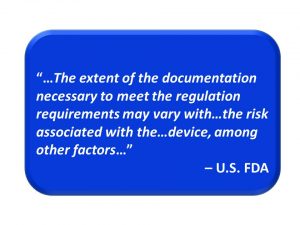
Our Industry’s Design Control Challenge
For more than twenty years, the U.S. Food and Drug Administration has identified insufficient design controls as a major factor in product recalls.
- In 2015 device quality system FDA-483’s, more Observations (536) involved the Design Controls subsystem than any other major subsystem of 21 CFR 820.
- Similarly, in 2015 device quality system Warning Letters, Design Controls violations appeared in 15% (102/690) of the citations, thereby ranking third.
- From 2003 to 2006, 54% of device quality system FDA Warning Letters included Design Control citations. In 2014 and 2015, this pattern progressed to where design control violations appeared in the majority (56%) of Warning Letters.
- In 1990 FDA published a study based on 5 years of recall data showing that nearly half of all recalls were due to deficiencies designed into the product.
- A seven-year FDA study published in 1991 showed that 90% of software-related device failures were design-related.
These data show that an effective design control system is crucial in avoiding consumer safety issues and reducing expensive recalls and compliance problems.
When reviewing ailing design control systems during audits and remediation efforts, the most notable observation made by ComplianceAcuity is that design control systems typically lack a tangible, user-friendly method for translating product concepts into functional results that meet user needs.

The ComplianceAcuity Design Control Solution
Aside from being a regulatory requirement, an effective design control system is a crucial business development tool.
Without a reliable way to define and translate product goals into corresponding outputs that are on target, medical device development quickly becomes expensive and can lead to dangerous outcomes.
Indeed, in the preamble to its Quality System Regulation, the U.S. FDA said:
“…The design process can become a lengthy and costly process if the design activity is not properly defined and planned…”
Cornerstones of ComplianceAcuity design controls:
- Risk Management clearly integrated and mapped to all stages of the design control process.
- Easy-to-use tools and guidance that will streamline unsustainable design control systems and eliminate unneeded procedures.
- Strategic design plans to identify and organize the numerous design and regulatory tasks, some of which run concurrently while others run in sequence.
- Concept documents prospectively identifying essential product goals before development starts. This ensures everyone is on the same page, and ultimately saves time and money.
- Tools that comprehensively facilitate design targets (inputs) that meet regulatory requirements and business goals. This phase is crucial because ambiguous or incomplete design input causes a ripple effect that can ultimately lead to devices that don’t meet user needs.
- Logical designation and differentiation of design verification and validation studies to reduce arbitrary and expensive deployment of tests that aren’t needed.
- Design History Files comprehensively showing the continuity of design history, from product inception to obsolescence.
Testimonials
“ComplianceAcuity built a foundation for Design Controls that carry forward to the current time which has made the whole design control effort more sustainable with current head count level”
- Sr. Quality Engineer, Class II & III Devices



